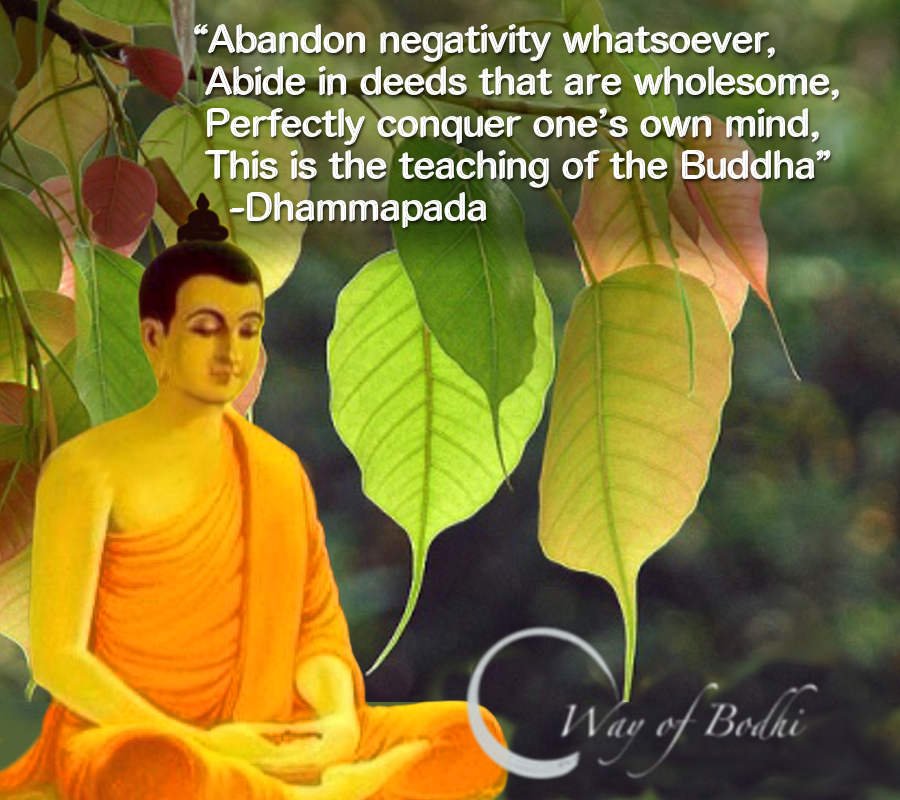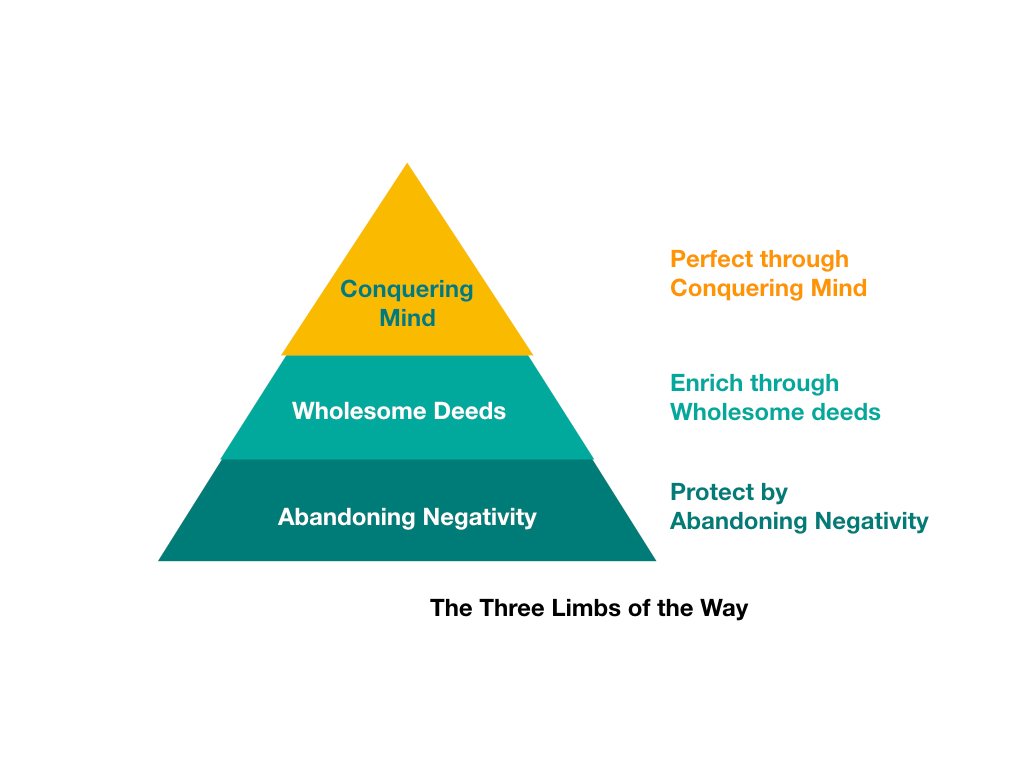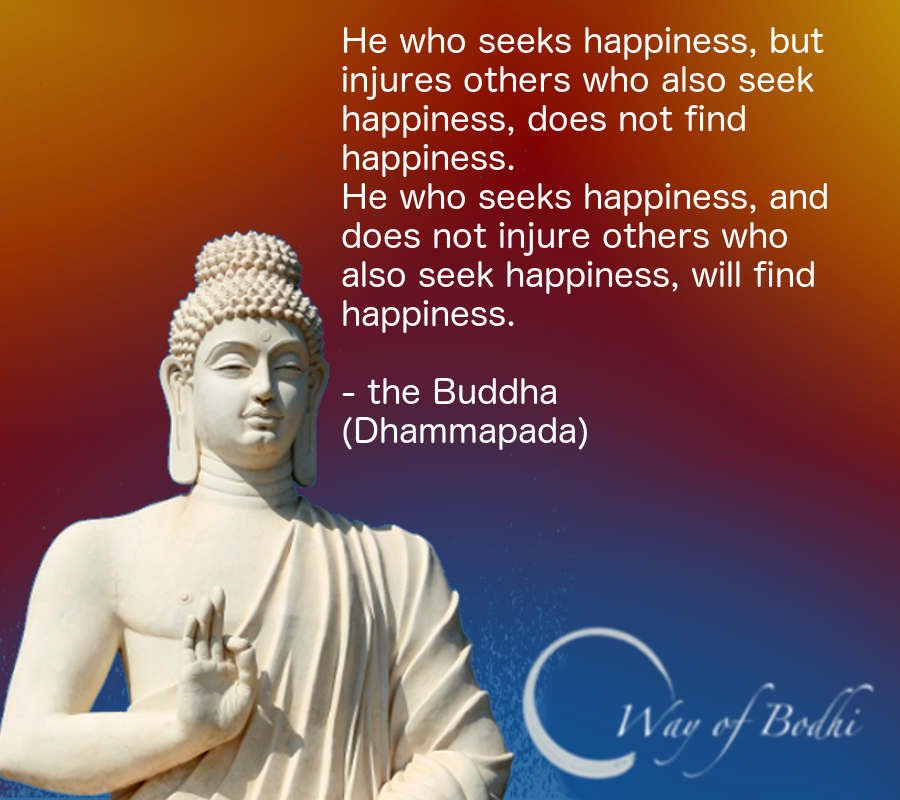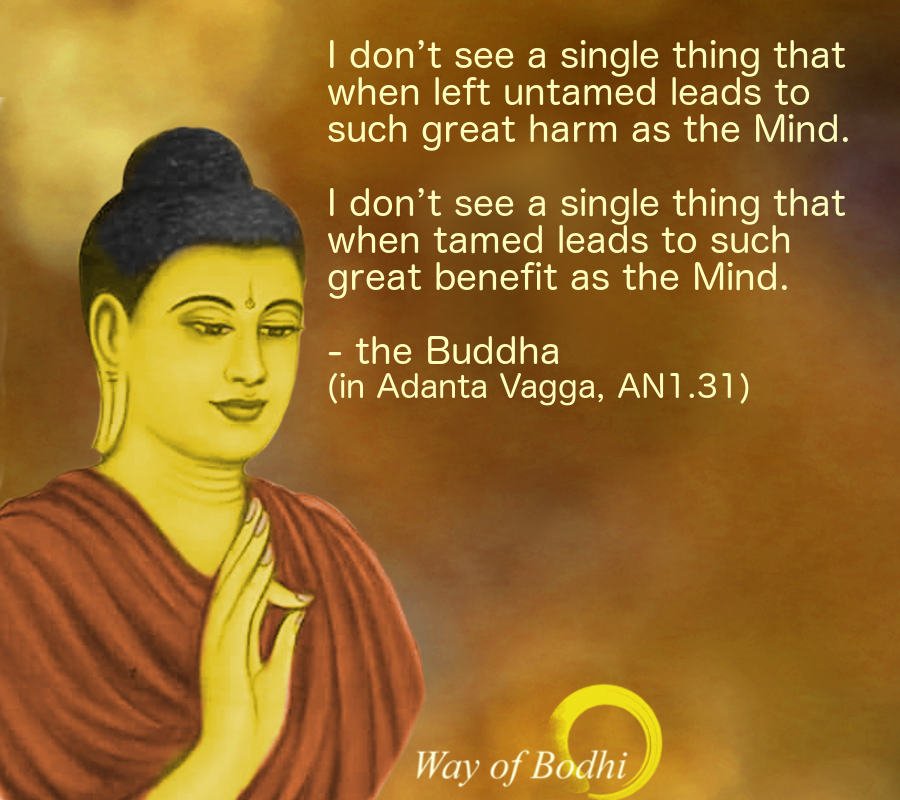The Way of Wholesome Living – Buddhism for Day to Day Life

The Buddha’s teachings are not only about Nirvana and Enlightenment. There is also a Way of Wholesome Living for those who haven’t set their aim on Nirvana. It is about enhancing wellbeing and cultivating skills for this life – Buddhism for day to day life. Even people who are totally occupied with their family and work responsibilities can easily benefit from this Way of practicing. In fact, this is what the Buddha taught to the largest segment of his disciples such as householders, peasants, merchants, kings, queens, courtesans, etc.
 What does Way of Wholesome Living mean? It is about molding one’s own thoughts, words and actions for greater wellbeing. It is about cultivating a healthy mind for a wholesome living. By developing qualities such as empathy, kindness, patience, steadiness, concentration, alertness, mindfulness, etc., it is possible to attain greater success in this world, in personal life as well as in the larger sphere as a responsible member of society. Through practicing the Way, one can remain peaceful and stress-free even in the midst of demanding situations, and at the same time be very effective and swift in one’s dealings with the world. We no more need to be slaves to our emotions. Instead, emotions can be our choice, and so is happiness.
What does Way of Wholesome Living mean? It is about molding one’s own thoughts, words and actions for greater wellbeing. It is about cultivating a healthy mind for a wholesome living. By developing qualities such as empathy, kindness, patience, steadiness, concentration, alertness, mindfulness, etc., it is possible to attain greater success in this world, in personal life as well as in the larger sphere as a responsible member of society. Through practicing the Way, one can remain peaceful and stress-free even in the midst of demanding situations, and at the same time be very effective and swift in one’s dealings with the world. We no more need to be slaves to our emotions. Instead, emotions can be our choice, and so is happiness.
This Way of Wholesome Living (Buddhism for day to day life) is suitable for anybody irrespective of whether one is a theist, atheist or agnostic. And, it doesn’t matter whether one is to able to resolve on the philosophical questions such as the continuity of life after death. You can simply work with what you can directly perceive here and now. The Way of Wholesome Living is not a rigid regime of practices. It varies depending upon the wishes, interest, aptitude and time-availability of the practitioner. The Buddha didn’t teach this as a religious package but gave guidance to different individuals depending on what suits them.
The Three Limbs of the Practice
In fact, the practical dimensions of all of the teachings of the Buddha, including those for Nirvana and Awakening can be summarized in his own words (Dhammapada 183) as below,
Abandon negativity whatsoever,
Abide in deeds that are wholesome,
Perfectly conquer one’s own mind,
This is the teaching of the Buddha
It has three parts. The first one is about abandoning harmful actions whatsoever. This is the easiest to follow once it is understood. That is also the first one to train in. The second is about entering into the domain of wholesome actions, speech and thought that are beneficial to self and others. The third is to work directly with one’s own mind to tame, transform and perfect it. The third is the most involved and uncommon aspect of the Buddhist Way. It requires some time for sitting and meditating. As we shall see, those who do not have any time to spare for mental training can still benefit from the first two limbs.
 These three – (i) refraining from negativity, (ii) engagement in wholesome actions, and (iii) working with one’s own mind – are the three aspects of practice. This is so no matter whether one wishes only for a Way of wholesome living in this life, or a Way towards Nirvana or Awakening. The variation is in the depths of understanding and practice. Let us see each of these in more detail, particularly in the context of the Way of Wholesome Living in this life.
These three – (i) refraining from negativity, (ii) engagement in wholesome actions, and (iii) working with one’s own mind – are the three aspects of practice. This is so no matter whether one wishes only for a Way of wholesome living in this life, or a Way towards Nirvana or Awakening. The variation is in the depths of understanding and practice. Let us see each of these in more detail, particularly in the context of the Way of Wholesome Living in this life.
Those who hardly have any time for sitting and taming the mind can still benefit by practicing the first limb (that of refraining from negativity) in all their daily activities. And, to the extent possible, they can enrich it through the second limb of intentionally engaging in wholesome deeds and thoughts. Just doing that much itself is far more beneficial than religious practices such as visiting many places of worship, pleading for divine help, observing religious festivals, etc. Further, to the extent possible, one can work on the third limb, that of familiarizing with and transforming one’s own mind. As the result of the third limb of practice settles in, the rest of it comes more naturally and the result will endure.
Abandoning Negativity
Let us be clear not to confuse this with the religiously defined ideas of sin and virtue. In Buddhism, negativity or pāpa (non-virtue) is not determined based on divine injunctions. Buddha just explained the natural laws of causation that he could directly observe. We can also intuitively arrive at similar inferences within the scope of what we can observe.
 In brief, whatever deeds of body, speech and mind that can cause harm to oneself or others is called ‘non-virtuous’ or ‘negativity’. It is not that if you do one of those actions it will lead to a divine judgement followed by punishment. Rather, the natural consequence of such actions, through the cause and effect dependencies, is harmful just as how touching fire can burn the finger. Negativity produces harm both outwardly and inwardly. Outwardly, certain actions cause harm to others, and as others tend to reciprocate, it also harms the harm-doer. Inwardly, it causes harm because the ripples of negative acts percolate in one’s own mindstream for a long time in the form of habitual undercurrents and affect one’s mental state in the future.
In brief, whatever deeds of body, speech and mind that can cause harm to oneself or others is called ‘non-virtuous’ or ‘negativity’. It is not that if you do one of those actions it will lead to a divine judgement followed by punishment. Rather, the natural consequence of such actions, through the cause and effect dependencies, is harmful just as how touching fire can burn the finger. Negativity produces harm both outwardly and inwardly. Outwardly, certain actions cause harm to others, and as others tend to reciprocate, it also harms the harm-doer. Inwardly, it causes harm because the ripples of negative acts percolate in one’s own mindstream for a long time in the form of habitual undercurrents and affect one’s mental state in the future.
Because of this, the Buddha said (Dhammapada 131-132),
He who seeks happiness, but injures others
Who also seek happiness, does not find happiness.
He who seeks happiness, and does not injure others
Who also seek happiness, will find happiness.
Nowadays, most people do not like to hear about restraint. Because, in religious contexts, the fear of divine punishment for negativity sometimes leads to anxiety, guilt (a feeling of deserving blame) and self-contempt. This is especially so when one impulsively ends up doing negative actions in spite of an earlier resolve not to do so. This is not the way the Buddha teaches us to train in restraint.
According to the teachings of the Buddha, there is a peaceful and gentle approach to abandoning negativity. Here, the training in restraint is not out of fear of judgement by an external force, but through the cultivation of a sense of responsibility for not creating harm. One’s own mind becomes more beautiful and shines better when such self-discipline is cultivated. Further, as one trains in mindfulness and vigilant awareness (as part of conquering one’s own mind), there is a greater presence of mind in one’s actions and there is a simultaneous awareness about one’s own emotional state. With that, it becomes easy and natural not to do negativity.
Abiding in Wholesome Deeds
Again, unlike religious teachings, wholesome (kuśala) deeds are not about performing religious rites or rituals. Wholesome are those deeds of body, speech and mind which bring benefit and wellbeing to oneself or others.
The process is similar to how negativity causes harm. Wholesome deeds bring about their results through natural cause and effect connections both outwardly and inwardly. Outwardly, by benefitting others, there is greater support from others for one’s own happiness. Inwardly, it creates a healthy state of mind for oneself. One’s mind tends to find contentment and happiness in more and more situations when habituated with wholesome thoughts, speech and actions.
As for the practice, this becomes easier and very enjoyable as you begin to notice that your mind is in a healthy and pleasant state after engaging in such deeds. Further, as you learn to conquer your own mind and cultivate qualities such as empathy and kindness, there will be a deep sense of joy in entering and abiding in wholesome deeds. You will get a big kick out of benefiting others.
Conquering One’s Own Mind
The most uncommon benefit of the Buddha’s Way of Wholesome Living is in its myriad tools for working with one’s own mind. Through taming the mind by steering it away from its confused habits, and by transforming it through practice, we can bring its innate goodness to perfect manifestation. The qualities such as empathy, kindness, compassion, patience, clarity of awareness, attention, steadiness, responsiveness, etc., are all naturally present in our minds. They do not shine forth only because they are obscured by confused habits. By conquering such habitual patterns through mental cultivation, we can reach greater levels of ease and perfection.
 Just as how one spends time daily or weekly in maintaining the health of one’s body if one were to spend a little time in attending to the health of one’s mind, one can attain great levels of wellbeing. Cultivating mindfulness and vigilant awareness through sitting meditation is a wonderful foundation for this. Mindfulness Meditation is for cultivating the presence of mind in whatever is happening right now. Simultaneously it strengthens the reflective awareness of the inner state of one’s own mind. Post-meditation, this training is gradually extended to all deeds of body, speech and mind in daily life. Training in mindfulness leads to greater tranquility and steadiness of mind along with greater precision, alertness and responsiveness.
Just as how one spends time daily or weekly in maintaining the health of one’s body if one were to spend a little time in attending to the health of one’s mind, one can attain great levels of wellbeing. Cultivating mindfulness and vigilant awareness through sitting meditation is a wonderful foundation for this. Mindfulness Meditation is for cultivating the presence of mind in whatever is happening right now. Simultaneously it strengthens the reflective awareness of the inner state of one’s own mind. Post-meditation, this training is gradually extended to all deeds of body, speech and mind in daily life. Training in mindfulness leads to greater tranquility and steadiness of mind along with greater precision, alertness and responsiveness.
The Buddhist teachings also provide a variety of tools for managing and overcoming destructive emotions such as anger and hatred, and for cultivating patience. This is another important aspect to living this life in a wholesome way.
Another important factor in achieving wellbeing in this life is to develop a sense of appreciation for the needs of fellow beings that occupy this world. We are all same in our fundamental needs – that of not wanting suffering and pain, and desiring happiness and wellbeing. Further, there is a deep interdependence between beings. Our needs in this world are met through the efforts of so many other beings. Moreover, our happiness depends on others’ happiness. We are happy in a world where others are happy. It is hard to be happy and peaceful in this world when others are suffering and discontentment. By training in loving kindness and compassion, one can turn this life into one of greater meaning and beauty.
Let our hearts blossom with loving kindness and compassion for all the beings in this world, without discrimination between far and near. Then, inwardly, we can naturally experience a greater sense of wellbeing. Outwardly, it makes the world a better place to live.
Learn more about the Way of Wholesome Living by reading the following …
How to be Cool and Cut the Fuel to Anger
The Army of Love and Compassion
The Boundless Heart of Loving Kindness (Metta)
The Austerity of Patience
The Power of Non-hatred
- This Moment – The Delight in this Day of Excellence - June 6, 2021
- A Drop of Kindness - February 13, 2020
- Precious than Gold – The Maski Rock Edict of Ashoka - December 3, 2018

